 |

Tools:








The Latest Video Game Consoles Have Launched – Now What?PS4, Xbox One, and WII U Face off Against Each Other - and New Technology
The PS4 and Xbox One were released during the second half of November and racked up worldwide sales of 4.2 million and 3.9 million units by end of the year. These are incredible numbers and echo what had happened when the 3rd- gen machines – the Xbox 360, the PS3 and the WII – were launched in 2005 and 2006 respectively. They ushered in an unprecedented upsurge in sales of both consoles and software as shown in the graph below:
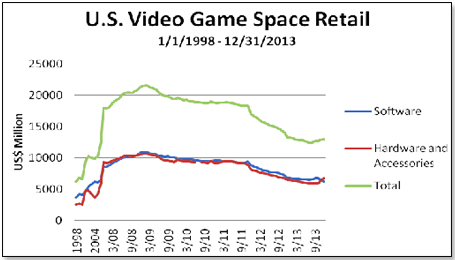
Source: NPD
We can hence expect a similar surge lasting for at least three or four years – or can we? We would – except for the development of the WII U.
This successor to the WII was released in November 2012, was very strong out of the gate and then fell off a cliff:
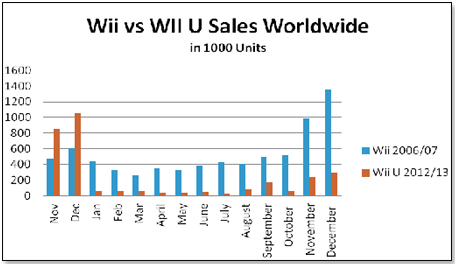
A number of reasons were cited for this abysmal performance – high price, consumer migration to other devices such as tablets, second rate graphics, lack of first-rate games etc. One that was not mentioned but may be in fact the most important of them all in the view held by the national buyers both in the U.S. and in Europe – the machine never crossed the chasm between the Innovators and the Early/Early Adopters on one side and the mainstream consumer on the other.
The chart below shows the typical adoption curve which also indicates that the first group before the Chasm represents about 10% of the total potential consumer group:
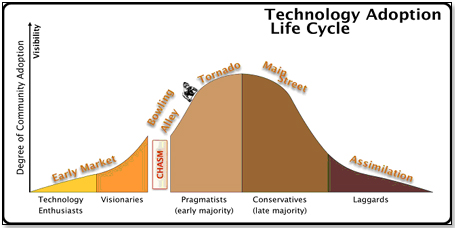
This Chasm is usually defined as the differentiator between those consumers who buy something because it is new and shiny or because it gives you a social cachet – in short, it is "cool" – and the vast majority who buy something because it is fundamentally more convenient or qualitatively better than what they already have. Too strong emphasis on the "cool" attributes could well be detrimental in attracting the second group interested in the practical plusses of a product.
In the case of the WII U, the judgement is in – the majority never came to the party. In the case of the two latest consoles – the PS4 and the Xbox One – the jury is still out but the buyers fear that the same could happen again in this instance – that the hardcore gaming fanatics lined up around the block to buy the new shiny gizmos and that the majority continues to stay away.
If this is the case then not only console sales but also game sales will be affected. There are early indications that this could be so. December 2013 video game software sales as reported by NPD were much lower than what you would expect in a period when major new consoles are launched. In fact, the buyers think that the weakness in software sales over the past year or so could be attributed not to consumers waiting for the next-gen consoles but rather to them gradually turning away from traditional games altogether and moving to the much cheaper games provided on smart phones and tablets.
One driver in this development is definitely the ongoing transition from hard copies to online games, a trend that has assumed rapid acceleration of late as demonstrated by the chart below:
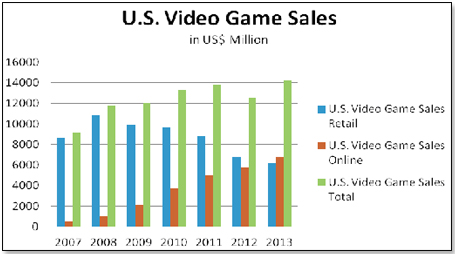
More games today are bought online in the U.S. than at brick-and-mortar stores and this trend is expected to continue. While in and by itself not necessarily negative at least for game publishers, industry executives are considering the possibility that this will force prices lower for online games - sufficiently below those currently in force to compensate for the loss in consumer revenue now gained through the resale of used games.
This is based on a study carried out by Masakazu Ishihara of the New York University Stern School of Business and Andrew Ching of the University of Toronto's Rotman School of Management in December 2012. In essence: "..... in the U.S., game prices should go down to about $40," Ishihara told Wired. "The reduction in price is partly driven by the fact that if the used game market were eliminated, gamers would no longer be able to sell their games and get back some money (so they need to be compensated)."
Such a price reduction would automatically lower Dollar sales volumes by one-third and this would really put the cat amongst the pigeons as far as the brick-and-mortar retailers are concerned because they could simply no longer compete. Particularly GameStop (GME) would suffer from this since they are today a one-pony show, totally dependent on video games software and hardware. The publishers such as Activision (ATVI), Electronic Arts (EA) and Take-Two (TTWO) would be pretty relaxed about this scenario since they consider pretty much any negative attached to a trend towards online gaming vastly preferable to what they have now – which is sharing their margins with retailers, competing against used games, and being eaten alive by pirates.
Rapid and massive adoption of tablets and smart phones for video gaming further complicates this picture. In their November 13, 2013, Digital Media Report, Bain & Company reported that:
· Smartphone ownership in developed markets (the U.S., U.K., France and Germany) jumped from 49 percent on average in 2012 to 64 percent in 2013; while increasing from 24 percent to 37 percent in developing markets (Brazil, Russia, India and China)
· Tablet ownership rose from 18 percent on average in 2012 to 39 percent in 2013 in developed markets; while increasing from 13 percent in 2012 in developing markets to 21 percent this year
On January 13, 2014, Haruhiro Tsujimoto, COO of Capcom, said that he sees a "momentous shift" in the makeup of the video game industry due to the popularity of smart phones and tablets combined with an increased social nature of gaming. He made also mention of "the momentous shifts in the composition of the entire game market caused by changes of an unprecedented magnitude. Among those key shifts include not advances in networks that have software sales moving away from packaged products to digital distribution, but also the "popularity of smart phones and tablets and the increasingly social nature of games."
Other than hurting brick-and-mortar retailers, this shift to tablets and smart phones should not worry the leading publishers – or should it?
This is how the top ten paid video games for smart phones lined up at Amazon middle of January 2014:
| Rank |
Game |
Publisher |
Price |
| 1 |
Mine Craft |
Mojang |
$6.99 |
| 2 |
Scribblenauts Remix |
Warner |
$0.99 |
| 3 |
Plants versus Zombies |
PopCap |
$0.99 |
| 4 |
Survival Craft |
Candy Rufus |
$3.99 |
| 5 |
Cut The Rope |
ZeptoLab |
$0.99 |
| 6 |
Mine Craft Game Guide |
GameLabs |
$2.99 |
| 7 |
Snail Bob |
Hunter Hamster |
$0.99 |
| 8 |
Hunger Games |
Reliance Games |
$0.99 |
| 9 |
Bike Race |
Top Tree Games |
$0.99 |
| 10 |
Terraria |
505 Games |
$1.99 |
Source: Amazon
This shows up two problems. One is that none of the leading publishers is amongst these providers. The other is that the top games offered by the leading publishers – whether at retail or online - all go for $59.99. This price discrepancy should be a matter of concern for these publishers In a situation where smart phones and tablets are becoming a major factor in video game viewing, They basically seem to have two unpalatable choices – they can either stay away from what is the growing segment of the market or they can begin to offer products which are competitive with what is already out there which means sacrificing margins and thus profits to a major degree.
Another development conceivably impacting the video game world is changing technology which will allow games to be streamed directly to TV sets, totally bypassing the need for consoles altogether. This is the promise of the Sony Play Station Now cloud-based streaming service to be unveiled later this year. All you would need is a controller and a TV screen. Also, both Apple and Google are reported to work on new ways to bring video games to consumers and neither is expected to use current console technology for this purpose.
Digi World has attempted to put all these variables into an overall video game forecast worldwide. This is shown below:
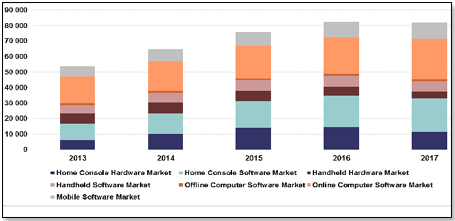
Source Digi World 11/19/2013
What Digi World is really saying is the following:
· Console sales will grow rapidly until 2015, then be flat for 2016 and decline thereafter
· Sales of handhelds will decline from 2015 onwards.
· The software market in all its formats will continue to grow pretty rapidly until 2017.
· The overall video game market – both hardware and software – will grow until 2016 and then flatten out.
I would add to this that executives at the leading video game publishers believe that games will virtually totally be online by 2020.
The video games industry is in the midst of a technological tsunami and we will know in a couple of years who has survived this perfect storm and who has not.
 Writer's Bio: Writer's Bio: Lutz Muller is a Swiss who has lived on five continents. In the United States, he was the CEO for four manufacturing companies, including two in the toy industry. Since 2002, he has provided competitive intelligence on the toy and video game market to manufacturers and financial institutions coast-to-coast. He gets his information from his retailer panel, from big-box buyers and his many friends in the industry. If anything happens, he is usually the first to know. Read more on his website at www.klosterstrading.com. Read more articles by this author
THIS BANNER IS AN AD:

Back to TDmonthly's front page
|  |
Advertise on TDmonthly

|

